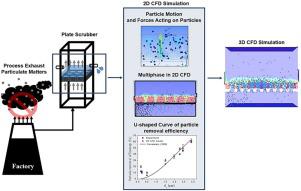Chemical Engineering Research and Design ( IF 3.7 ) Pub Date : 2020-06-27 , DOI: 10.1016/j.cherd.2020.06.024 Siao-Han Huang , Jia-Lin Kang , David Shan-Hill Wong , Shi-Shang Jang , Chao-An Lin

|
In this study, a computational fluid dynamics (CFD) model of a sieve plate scrubber was built to predict its particle-removal efficiency and predict the U-shaped curve of the particle-removal efficiency as particles became smaller. Due to the complexity of particle tracking, it takes considerable time to simulate the model by using a three-dimensional (3D) structure, which is not conducive to finding the appropriate setting of particle forces. Instead, we presented a dimension-reduction method to estimate the particle force setting by using a two-dimensional (2D) structure. The rationality of the dimension-reduction method was validated by the consistency in froth density for both 2D and 3D models at various air-inlet velocities. Furthermore, the result of the particle forces setting showed that besides the drag force, other forces, such as the lift force, pressure-gradient force, gravity force, and virtual mass force, should be employed in the CFD model to predict the particle-removal efficiency of the sieve plate scrubber. The prediction results of the 2D model remarkably matches the particle-removal efficiency results of experimental data from the literature for various gas velocities and particle sizes. In addition, the model predicts the U-shaped curve of the particle-removal efficiency for the particle-diameter range from 0.1 to 1.0 μm. Furthermore, a 3D model with the setting of the particle forces as in the 2D model was used to validate the consistency between the 2D and 3D models. The result showed that the particle-removal efficiency of the 3D model was considerably close to the prediction results of the 2D model.
中文翻译:

通过计算流体动力学的降维预测筛板洗涤塔中的颗粒清除
在这项研究中,建立了筛板洗涤器的计算流体动力学(CFD)模型,以预测其颗粒去除效率,并预测随着颗粒变小,颗粒去除效率的U形曲线。由于粒子跟踪的复杂性,通过使用三维(3D)结构来模拟模型需要花费大量时间,这不利于找到合适的粒子力设置。相反,我们提出了一种降维方法来通过使用二维(2D)结构来估计粒子力设置。通过在各种进气速度下2D和3D模型的泡沫密度一致性,验证了尺寸缩减方法的合理性。此外,粒子力设置的结果表明,除了阻力之外,其他力 在CFD模型中应采用诸如升力,压力梯度力,重力和虚拟质量力之类的值来预测筛板洗涤器的除尘效率。2D模型的预测结果与各种气体速度和粒径的文献中实验数据的去除效率结果非常匹配。另外,该模型预测了对于0.1-1.0μm的粒径,颗粒去除效率的U形曲线。此外,使用具有2D模型中的粒子力设置的3D模型来验证2D和3D模型之间的一致性。结果表明,3D模型的颗粒去除效率与2D模型的预测结果相当接近。在CFD模型中应使用虚拟质量力和虚拟质量力来预测筛板洗涤器的除尘效率。2D模型的预测结果与各种气体速度和粒径的文献中实验数据的去除效率结果非常匹配。另外,该模型预测了对于0.1至1.0μm的粒径,颗粒去除效率的U形曲线。此外,使用具有2D模型中设置的粒子力的3D模型来验证2D模型和3D模型之间的一致性。结果表明,3D模型的颗粒去除效率与2D模型的预测结果相当接近。在CFD模型中应使用虚拟质量力和虚拟质量力来预测筛板洗涤器的除尘效率。2D模型的预测结果与各种气体速度和粒径的文献中实验数据的去除效率结果非常匹配。另外,该模型预测了对于0.1至1.0μm的粒径,颗粒去除效率的U形曲线。此外,使用具有2D模型中设置的粒子力的3D模型来验证2D模型和3D模型之间的一致性。结果表明,3D模型的颗粒去除效率与2D模型的预测结果相当接近。应在CFD模型中使用,以预测筛板洗涤器的颗粒去除效率。2D模型的预测结果与各种气体速度和粒径的文献中实验数据的去除效率结果非常匹配。另外,该模型预测了对于0.1至1.0μm的粒径,颗粒去除效率的U形曲线。此外,使用具有2D模型中设置的粒子力的3D模型来验证2D模型和3D模型之间的一致性。结果表明,3D模型的颗粒去除效率与2D模型的预测结果相当接近。应在CFD模型中使用,以预测筛板洗涤器的颗粒去除效率。2D模型的预测结果与各种气体速度和粒径的文献中实验数据的去除效率结果非常匹配。另外,该模型预测了对于0.1至1.0μm的粒径,颗粒去除效率的U形曲线。此外,使用具有2D模型中的粒子力设置的3D模型来验证2D和3D模型之间的一致性。结果表明,3D模型的颗粒去除效率与2D模型的预测结果相当接近。二维模型的预测结果与各种气体速度和粒径的文献中的实验数据的去除效率结果非常匹配。另外,该模型预测了对于0.1-1.0μm的粒径,颗粒去除效率的U形曲线。此外,使用具有2D模型中的粒子力设置的3D模型来验证2D和3D模型之间的一致性。结果表明,3D模型的颗粒去除效率与2D模型的预测结果相当接近。二维模型的预测结果与各种气体速度和粒径的文献中实验数据的去除效率结果非常匹配。另外,该模型预测了对于0.1-1.0μm的粒径,颗粒去除效率的U形曲线。此外,使用具有2D模型中的粒子力设置的3D模型来验证2D和3D模型之间的一致性。结果表明,3D模型的颗粒去除效率与2D模型的预测结果相当接近。与2D模型中一样,使用具有粒子力设置的3D模型来验证2D和3D模型之间的一致性。结果表明,3D模型的颗粒去除效率与2D模型的预测结果相当接近。如2D模型中那样,通过设置质点力的3D模型来验证2D模型和3D模型之间的一致性。结果表明,3D模型的颗粒去除效率与2D模型的预测结果相当接近。











































 京公网安备 11010802027423号
京公网安备 11010802027423号